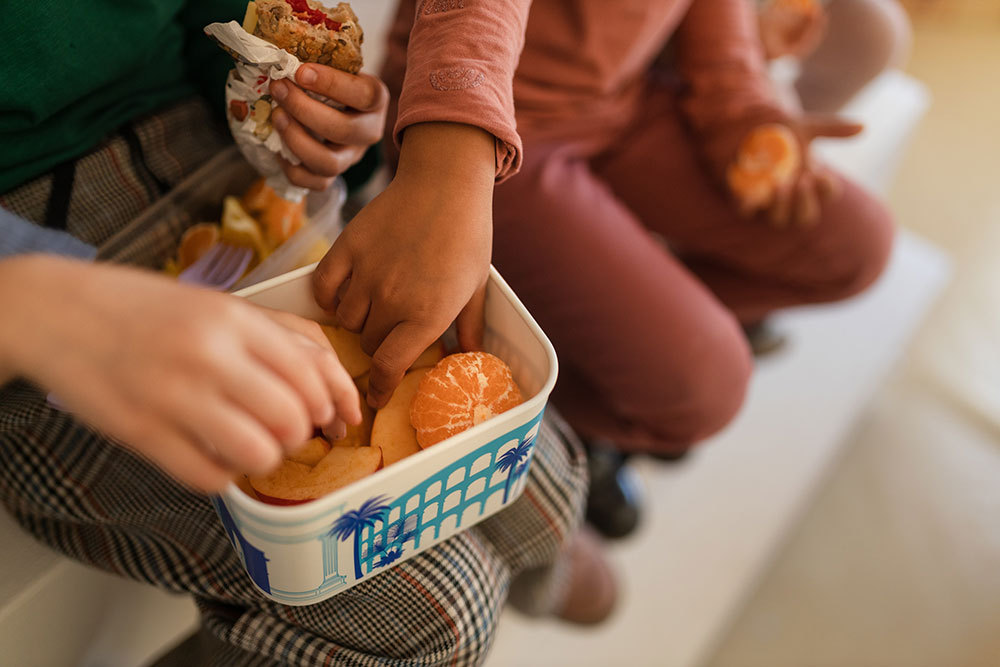20 Allergy-Friendly Foods and Snacks for Back-to-School

Yummy options to keep your hungry kid happy and their classmates safe.
By Ashley Zeigler
I will never forget the time my nephew came to my house, ate a bowl of cereal, and had such a bad allergic reaction that we were moments away from needing to administer his EpiPen. He has a life-threatening peanut allergy, and even though the cereal and milk he ate were free of allergens, the clean spoon he ate with had scooped peanut butter from a jar at some point in the past. It was a terrifying experience and a sobering reminder of how serious food allergies can be.
Food allergies affect 1 in 13 children, according to the Centers for Disease Control and Prevention (CDC), which comes out to around two kids per classroom in the U.S. That means, even if you don’t have to think twice about what you put in your little one’s school lunch, there’s a chance their best friend’s parent has to be more cautious. And even though it might be a real battle trying to figure out a lunch alternative for your PB&J-loving kid, trust me when I say the daily struggle is better than the guilt you will feel if your child’s food is the reason for a classmate’s allergic reaction.
General Food Allergy Safety Practices
These days, since food allergies are so common, a lot of schools and childcare centers have implemented rules and guidelines to ensure students are packing allergy-free snacks and/or lunches. In fact, it’s not at all uncommon for certain allergens to be banned altogether in an effort to keep students safe. While this may have allergy-parents breathing a sigh of relief (and, can you blame them?), parents of kids without food allergies might find themselves feeling a little lost. Thankfully, the situation is easier to navigate than you may realize.
According to the organization Food Allergy Research and Education (FARE), the most common food allergies (in order) are shellfish, milk, peanut, tree nuts, egg, fin fish, wheat, soy, and sesame. Even though shellfish is the most prevalent food allergy, it’s not one that many schools will ban entirely—but that’s probably because you don’t see a lot of first-graders showing up to school with lobster tail, crab legs, and shrimp cocktail in their lunchboxes. Not only that, but shellfish is an allergen that is fairly easy to spot on an ingredient list and avoid, usually because it is the main ingredient.
The top allergens you’re most likely to come across in your child’s classroom or school cafeteria are peanuts, tree nuts, milk, egg, or wheat. They may not be totally banned from lunches, but if your little one likes to have lunch with a friend with one of these allergies, it’s important to be mindful of the foods you pack because, for some kids, all it takes is a little exposure to cause a reaction.
Generally, you can trust fresh fruits and veggies to be safe allergy-free snacks. Still, it’s good practice to always make sure these food items are cleaned before packing them in your kid’s lunchbox, just in case they previously came into contact with an allergen (and also because they’re usually pretty dirty anyway). Most meats are considered safe as well (except seafood), but it’s still important to be conscious and glance over the ingredients list of anything with a label.
Checking packaged foods for allergens is fairly straightforward. Simply look at the ingredients list and follow it all the way to the end. After the final ingredient, it should say “CONTAINS” with a list of allergens after, and it is often in bold text so that it stands out from the rest of the ingredients list.
If you’re dealing with a severe allergy, things become a bit trickier. In these cases, cross-contamination can trigger an anaphylactic response (see the cereal spoon anecdote above). Even if you’re purchasing food that, theoretically, shouldn’t contain an allergen, it’s still important to check the label because it will tell you if the product was processed in a facility that also processes nuts, wheat, soy, etc., which could result in cross-contamination.
So, what are some allergy-friendly food and snack ideas you can safely pack in your child’s lunchbox? Here are some suggestions, depending on the allergen you’re trying to avoid.
Peanut and tree nut allergy-friendly foods
- Apple slices with a peanut butter alternative like Wowbutter or SunButter
- Waffles or pancakes with syrup (or a little butter and cinnamon-sugar mix for something less sticky)
- Crackers with cheese and deli meat
- Macaroni and cheese
- Cold pizza
Just a note: Not every kid who has a peanut allergy is allergic to tree nuts, and vice versa. A lot of schools and childcare centers lump them together when they’re making “nut-free” food guidelines, but they will be listed as separate allergens on food labels.
Milk allergy-friendly foods
- Hot dogs
- Cheese-free sandwiches or wraps like a turkey BLT
- Hard-boiled eggs
- Graham crackers with a fruit mix and jam or honey (try Nabisco Honey Maid Honey Graham Crackers)
- Chicken nuggets with dairy-free breading (try Tyson)
Egg allergy-friendly foods
- Rice with meat
- Cottage cheese
- Tomato soup with egg-free crackers (try Kellogg’s Keebler Club Crackers)
- Yogurt with dried fruit and crunchy granola (try Good & Gather Strawberry Shortcake Granola)
- Baked or mashed potatoes
Gluten-free foods
- Tortilla chips and salsa (try Siete Foods Sea Salt Grain Free Tortilla Chips)
- String cheese
- Turkey and cheese in a flourless or corn tortilla wrap (try Mission Gluten Free Original Tortilla Wraps)
- Rice cakes with chickpea hummus (try Sabra Classic Hummus)
- Fruit smoothie with yogurt
This may seem like a big task on the surface, but remember, by putting in the extra time and work to ensure your child’s school snack or lunch is allergy-friendly, you’re helping to put another parent’s mind at ease when they send their food-allergy kiddo to school every day. Plus, when it’s time for an after-school snack, your little one will be free to enjoy life with all the peanut butter cookies (or lobster tail) their heart desires.








